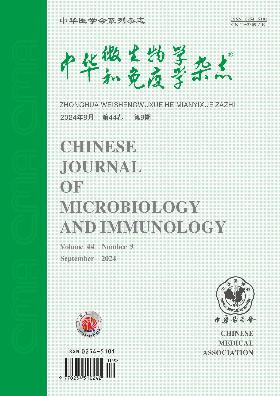志贺毒素研究进展
Q4 Immunology and Microbiology
引用次数: 0
摘要
志贺毒素(Stx)是志贺菌和某些大肠杆菌的重要毒力因子,可分为志贺毒素1(Stx1)和志贺毒素2(Stx2)。Stx由λ样噬菌体编码,通过从28S rRNA中去除腺嘌呤残基来阻断蛋白质合成。Stx还可以通过多种途径诱导细胞凋亡。当感染志贺毒素产生菌时,人类可能会出现腹泻、出血性结肠炎(HC)和溶血性尿毒症综合征(HUS),甚至死亡。目前,Stx引起的疾病尚无特效治疗方法。近年来,Stx在癌症治疗和影像学中的应用引起了人们的极大兴趣。本文从Stx的命名、分型、结构、遗传学、发病机制和应用前景等方面对其进行了简要综述。关键词:志贺毒素;痢疾志贺菌;产志贺毒素的大肠杆菌;λ样噬菌体本文章由计算机程序翻译,如有差异,请以英文原文为准。
Advance in Shiga toxin
Shiga toxin (Stx), which can be divided into Shiga toxin 1 (Stx1) and Shiga toxin 2 (Stx2), is an important virulence factor of Shigella spp. and certain strains of Escherichia coli. Stx, encoded by λ-like phage, blocks protein synthesis through removal of an adenine residue from the 28S rRNA. Stx can also induce apoptosis through multiple pathways. Humans may suffer from diarrhea, hemorrhagic colitis (HC) and hemolytic uremic syndrome (HUS) and even death when infected with Shiga toxin-producing bacteria. At present, there is no specific treatment for diseases caused by Stx. In recent years, the application of Stx in cancer therapy and imaging has aroused great interest. This review provided a brief overview of Stx in its nomenclature, typing, structure, genetics, pathogenesis and application perspectives.
Key words:
Shiga toxin; Shigella dysenteriae; Shiga toxin-producing Escherichia coli; λ-like phage
求助全文
通过发布文献求助,成功后即可免费获取论文全文。
去求助
来源期刊

中华微生物学和免疫学杂志
Immunology and Microbiology-Virology
CiteScore
0.50
自引率
0.00%
发文量
6906
期刊介绍:
Chinese Journal of Microbiology and Immunology established in 1981. It is one of the series of journal sponsored by Chinese Medical Association. The aim of this journal is to spread and exchange the scientific achievements and practical experience in order to promote the development of medical microbiology and immunology. Its main contents comprise academic thesis, brief reports, reviews, summaries, news of meetings, book reviews and trends of home and abroad in this field. The distinguishing feature of the journal is to give the priority to the reports on the research of basic theory, and take account of the reports on clinical and practical skills.
 求助内容:
求助内容: 应助结果提醒方式:
应助结果提醒方式:


